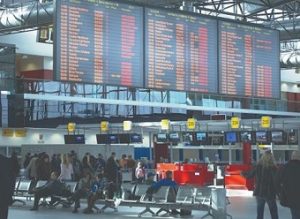
The relaxation of Covid restrictions has been followed by record rising passenger numbers. Heathrow, the UK’s busiest airport, reported it was used by 4.2m passengers in March – its busiest month since the start of the pandemic. However, airports have simultaneously been dealing with staff shortages due to sickness which has led to flight cancellations and concerns for passenger safety.
Airports can be confusing places and cause stress amongst passengers. This can sometimes escalate into security and safety issues. Such instances have increased post-pandemic with new regulations, rules and processes being put in place for passengers to understand.
With a further boom in travellers expected in the approaching summer, airports are in great need of support. Here, Anthony Incorvati, Segment Development Manager, Transportation at Axis Communications explains how new intelligent video surveillance solutions can address the challenges of airports and in doing so help manage and protect these increasingly crowded areas.
Airports are expansive in nature, with numerous areas and individuals to monitor. Surveillance technologies and edge analytics can be used to assist airport operators in monitoring passengers.
One example of this is people counting software which can provide an overall view of passengers in the terminal – both landside and airside – in real time. This data can be used to inform decisions, such as staffing levels during peak times. Additionally, heat maps can enable alerts of particularly crowded areas.
High passenger numbers can present the need for queue monitoring technology which enables the tracking of how many people are standing in a predefined area (for instance at a check-in desk, for passport control or security) and the level of activity within that area. It can also be used to trigger real-time push alerts to airport staff or speakers if the queue is too long. Not only this, but queue monitoring can also provide the average waiting time and churn rates, allowing staff to swiftly make alterations such as opening new check-in desks and security stations to alleviate queues and the stress that comes with them.
The airport staff shortages in connection to eased Covid restrictions and an uplift in cases are hopefully short-term. However, this will also have prompted airport operators to think about where increased automation could be used within airports to manage passenger flow. Surveillance technology and edge analytics can play a key role here. For example, network cameras can be employed to monitor entrance points such as checkout terminals, all while being operated entirely from a central control room while offering airport operators full visibility of operations.
Network cameras can also support airport security teams in deterring offending behaviour before it takes place or escalates. Just the presence of a camera as a “digital witness” can make offenders rethink their actions. Additionally, by combining with network audio can prove to be a powerful tool for deterrence, both on its own and in combination with video.
A camera can prompt an automated audio warning or alert an operator to give a live warning using the audio system. This can help operators create efficiencies in response to crowding and incidents. For example, audio sensors can be used to detect raised and angry voices, alerting security staff to verify by surveillance camera and deploy on-the-ground staff appropriately, which also encourages the most efficient use of security personnel – optimising resources and making the airport safer.
Network audio can be used to help direct passengers in the terminal and pass on security and safety instructions – either live or pre-recorded. This can be of crucial impact in cases where passengers and others in the area need to be informed of an incident and guided away from danger. In the case of an emergency, it’s crucial that audio instructions and warnings come through loud and clear, without distortion. The quicker people understand the instructions being given to them, the quicker they will follow them and do so correctly.
With network audio systems being 100% digital – from source to speaker – clarity isn’t lost along the way. Network audio solutions enable airports to easily create and manage zones and ensure information is delivered exactly where it’s needed.
Surveillance cameras, audio and analytics can be used to better manage the flow of people through an airport and in doing so, support safety, security measures, and operations. The technologies offer around the clock perimeter protection ranging from monitoring passengers and maintaining orderly systems, to deterring disruptive behaviour and promptly acting upon emergency situations.
Surveillance technology provides efficient and much-needed support to airport security teams particularly in dealing with the present challenges of staff and passenger numbers which are expected to continue in the coming months. Even when these challenges are eased, surveillance technology and analytics can continue to optimise the efficiency of activity within airports.











